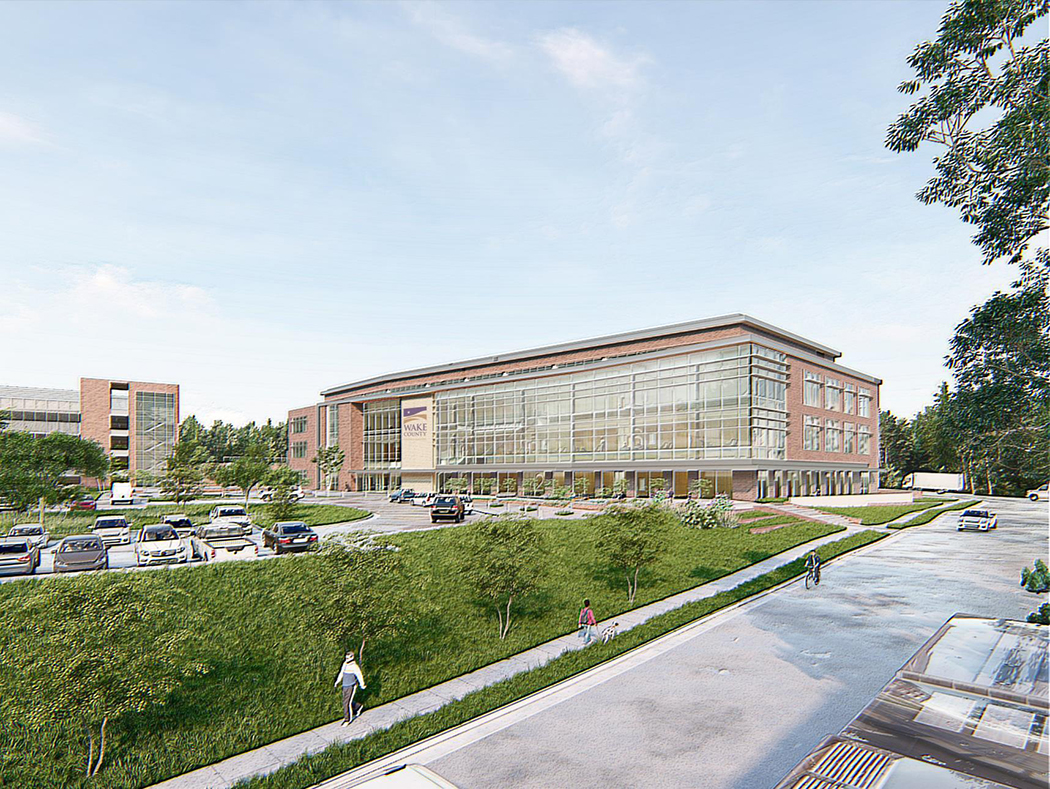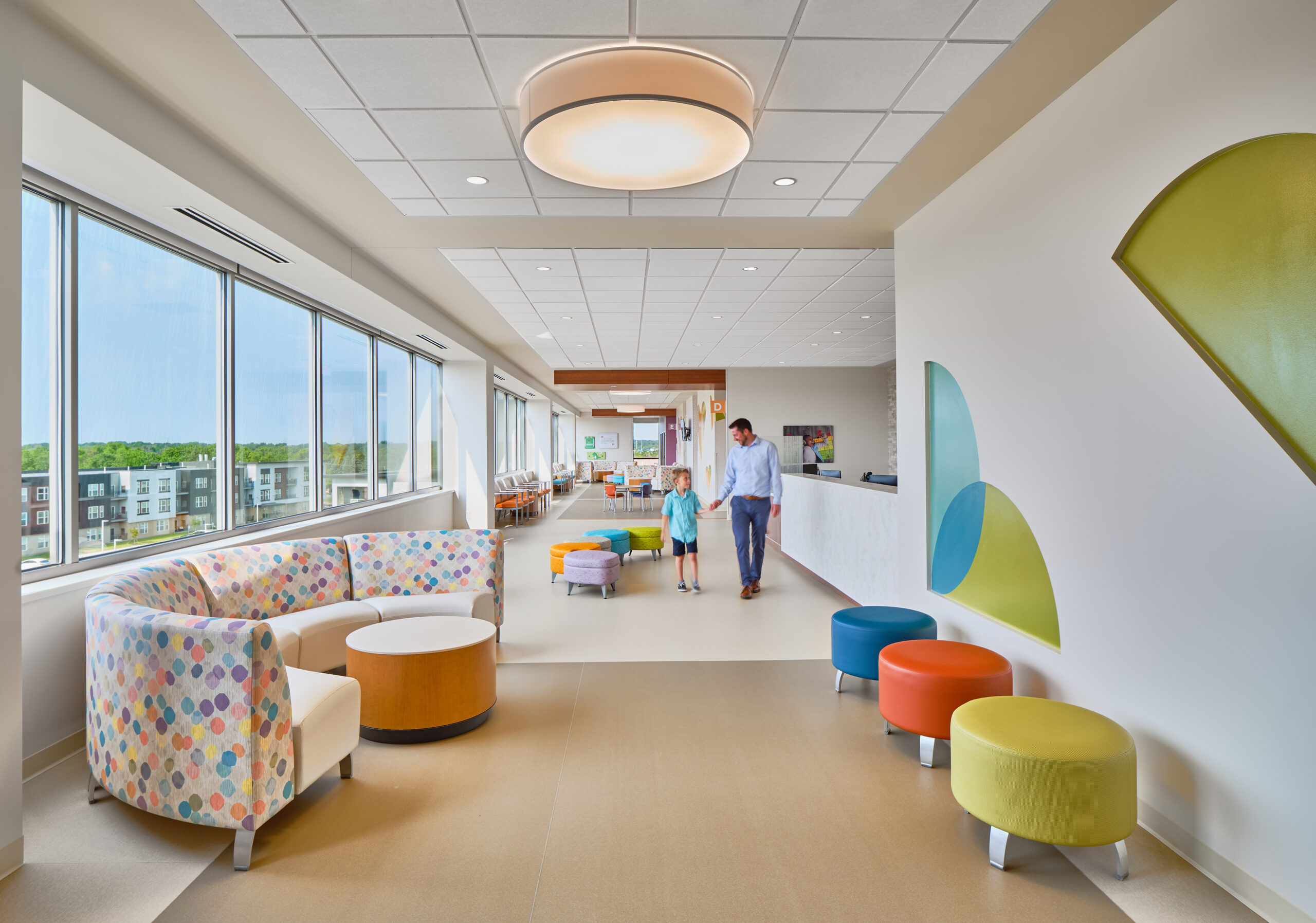By Aaron Fulton
Addressing the need for well-designed behavioral health facilities is critical. From 2007 to 2017, the CDC reported a 40 percent increase in suicide rates, making it the 10th leading cause of death. In Iowa alone, suicide is the ninth leading cause of death. Although these numbers are startling, there are numerous medical facilities across Iowa and the nation working to address the country’s growing behavioral health needs. One such facility is MercyOne North Iowa Medical Center in Mason City, Iowa. RDG’s work on this project, which was designed in collaboration with BWBR, the Design Architect and Behavioral Health Planner, helped us establish three critical considerations where design can support the treatment and well-being of patients: admittance procedures, patient rooms and patients’ overall sense of control.
Design for the First Impression
For patients and loved ones, the intake room is their first point of contact. Creating a dedicated intake room can help expedite the admittance process and allow specialists to see patients more quickly. In addition to reducing the time it takes to admit patients, placing intake rooms near security and other needed amenities (e.g. lockers for patients’ personal belongings), helps ensure a safe area where providers can start or finish evaluations, and where patients can change into scrubs or gowns before entering a unit floor.
The behavioral health intake room at MercyOne North is its own dedicated space, part of an “on-stage, off-stage” design that separates it from the rest of the unit. Tim Mason, nurse manager of behavioral health services at Mercy North Hospital, explains how this approach has made a positive impact on the overall patient experience: “We strive to have the time it takes from the moment patients first enter the emergency department to when they step onto the unit floor be 120 minutes or less. [Since the addition completed], we’ve seen a significant decrease in the number of patients having to wait in ED rooms.” Positioning the intake room “off-stage” helps moderate anxiety for new or current patients and allows staff members to work in a space out of sight but still within proximity to patients in case treatment or intervention is needed. The “on-stage, off-stage” approach also helps mitigate distraction, enabling providers to be more efficient in their clerical work and separating high-risk individuals from sensitive areas like medication rooms.
The behavioral health intake room at MercyOne North is separate from the rest of the unit, helping to expedite the admittance process and allow specialists to see patients more quickly.
MercyOne North’s Behavioral Health Unit also includes a central nurse station with open site lines and features that encourage staff and patient interaction without appearing overbearing or institutional. Should they need to, staff can step back into lockable spaces to allow for security or additional aid, while at the same time allowing staff to conduct work just as they would in any other part of a hospital.
Design to Support Settling In
For behavioral health facilities, patient room design is especially critical in helping reduce risk and maintain a sense of dignity and comfort. Taking cues from the hospitality industry, design for these spaces can include amenities such a desk or armoire and a mix of engaging colors and natural materials, which help create a greater sense of control and alleviate stress. Additional amenities – exercise rooms, group therapy spaces, lounging areas – add a sense of familiarity and help deinstitutionalize the environment. While items like furniture and fixtures should be anti-ligature or fixed to prevent harm, subtle changes in the way we design and present these elements can ultimately help destigmatize the environment; as Mason explains, “Even though [patients] may be forced to be here, they are not prisoners. Providing an environment that’s warmer and more open gives the feeling of a place that’s providing help.”
- Furniture that is tamper-proof, doors that are ant ligature and windows with integral blinds and lamented glass are a few basic steps to ensure patients are safe in the privacy of their rooms.
- Resilient materials such as laminated woods and solid surfaces offer longevity as well as a sense of higher design that feels more hospitality-centered versus institutional.
- Offering multiple seating and leisure options within a patient’s room can help give a sense of control. These areas can also be positioned to be in a direct line of sight of the door and encourage productive activities such as reading or watching the natural environment outside the window.
- Providing natural daylight contains natural “cues” that help regulate the human circadian clock and activate the hormones required for normal biological functions and regulate mood.
- Incorporating cooler colors in the overall pallet can create a calming environment, while warm wood grain VCT flooring offers an easily maintainable material that helps bring depth to a room.
- Providing a TV behind a well-designed tamper-proof case can create a sense of control and familiarity. Override controls combined with set hours of screen time for patients can allow for positive distraction and decompression.
- Adding fixed, anti-ligature paintings or pictures to a room may serve as a positive distraction for patients and create a design that feels more hospitality-centric, rather than clinical.
- Encouraging patients to personalize their rooms by bringing in pictures or offering them books from the facility’s library can create a greater sense of control, instill a personal connection to the space and serve as a positive distraction.
(See featured image above for specific examples in use.)
Maintaining visual confirmation of patients’ whereabouts is vitality important, particularly when they are left alone in their rooms. Designing the overall space to maximize site lines to patient rooms allows for less obvious observation methods, such as windows or cameras, and can help offset feelings of unease or paranoia. A simple sidelight at the door in conjunction with a camera enables practitioners to observe patients in a way that feels supportive rather than controlling. Likewise, lighting plays a critical role in enhancing mental well-being. Daylight contains natural “cues” that help regulate the human circadian clock and regulate mood, so it’s important to provide access to views to the outside as well as exposure to natural light. Color tuning artificial light, which mimics the daylighting cycle and allows for changes in intensity and color, can also assist in patients’ overall sense of comfort.
Design for a Greater Sense of Control
Whether in patient rooms or in activity or common spaces, offering patients a greater sense of environmental control can aid in treatment and improve demeanor. One innovative example of this is MercyOne North’s sensory room. Equipped with controls to change the color or brightness of the lighting, speakers that can play music or soothing sound effects and comfortable, plush seating, the room offers a space where patients with heightened anxiety or who feel overstimulated can come to decompress. “Our staff can recognize when patients are getting upset or worked up and direct them to the sensory room,” explains Mason. “This allows for those patients to get some quiet time, listen to music, meditate or read. Staff can also sit in there with individuals and talk through the situation to help calm things down.”
Behavioral health facilities are often associated with sterile design elements, but safe design doesn’t have to equate to design that looks and feels overtly institutional. By using materials that evoke comfort and subtly incorporating ways to monitor patients, these environments can ones that feel supportive rather than punitive. Many of the concepts in this article follow current best practices, but as our understanding of mental health treatment evolves, it’s critical to consider new and potentially more effective approaches that can contribute to the overall comfort and well-being of behavioral health patients and those who care for them.
Aaron Fulton, Associate AIA is an architectural intern at RDG Planning & Design. An experienced designer and technician, Aaron brings his deep understanding of design standards to work for the firm’s Healthcare Studio.






